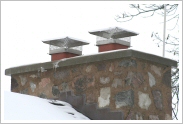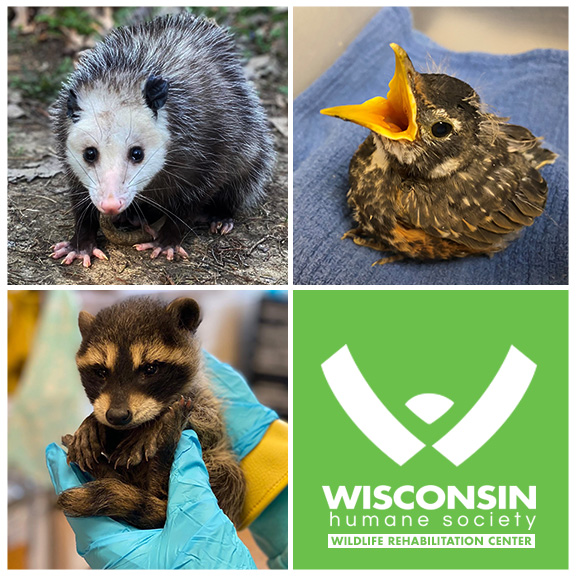Wild Animal in the Chimney or Fireplace
"Help! There is a wild animal trapped in my chimney or fireplace!"
CLICK HERE for a print-friendly PDF and photos!
Situation:
You can see or hear what you think is a wild animal in your chimney or fireplace.
Why This Happens:
Some species of wild animals are “cavity nesters,” that is, they normally look for holes in hollow trees in which to find shelter, or den space for raising their young. Open chimneys resemble a hollow tree enough to attract these species. Some animals, like raccoons, can usually climb in and out of a chimney at-will. Other species, like squirrels, are seldom able to get out on their own. Any bird that gets into a chimney (other than Chimney Swifts, who build a small nest attached to the inside of the chimney) will NOT be able to get out on its own! These animals will die unless they are rescued or given an alternate means of exit.
FAQs & Humane Solutions:
“I don’t think I have an animal in my chimney right now, but I want to make sure that one doesn’t get in there. What can I do to keep animals out?”
Install a chimney cap. A chimney cap is a metal mesh cover, usually with a peaked, solid top. You can get a professional chimney sweep service to install the cap or caps, or, if you are able-bodied, handy, and have a suitable ladder, you may be able to install a cap yourself. If you are going to install a cap yourself, you’ll need to get up on our roof and measure the chimney opening so you know what size cap you’ll need. Before going on the roof, please take the time to set up your ladder properly, make sure that the ladder is secure so it can’t slip or fall (you may want to get someone to hold the ladder for you), hang onto the ladder with both hands when climbing and descending, wear shoes with non-slip soles, and stay off the roof when it is wet or snow-covered. Chimney caps for DIY-ers are available from home improvement centers, some hardware stores, and online. Avoid caps made from aluminum, since they are not as sturdy as steel caps and a raccoon may be able to pull an aluminum cap off or pull it apart. Most caps don’t require any drilling and just fit onto the top of the chimney opening and are held in place by screws. Before installing a cap, inspect your chimney to make sure that no animals are present.
“I hear some kind of animal in my chimney above the fireplace. I think it might be raccoons. Should I light a fire to drive them out?”
Please DON’T. We have seen many cases of animals with smoke-inhalation and/or severe burns caused by people trying to smoke them out! If a raccoon family is present, the smoke usually drives the mother raccoon out in a panic and she does not have time to evacuate her babies. The babies, and often the mother, suffer from smoke inhalation and get badly burned or even killed.
“I know I have a raccoon in the chimney above my fireplace. I think she has babies because I hear “chittering” or “churring” sounds, and sometimes crying, especially at night. How can I get them to leave?”
Tolerance: If you are willing, you may choose to let her continue to tend to her babies in the chimney for a few weeks. She will not damage the chimney. To reduce the sound of the babies inside your house, you may want to temporarily place a piece of plywood or other sturdy panel over your fireplace opening. When the babies are about 8 weeks old, the “kids” begin following their mom on her nightly forays in search of food. At that point, she’ll usually move out, and you can then have the chimney capped.
Hazing: If you’ve decided that you just can’t stand having the raccoons living in your chimney, you can encourage them to move out. Bear in mind though that this is not without some risk of the mother abandoning one or more of her babies. The raccoon moved into your chimney because it is relatively warm, dry, dark, quiet, and feels safe inside, much like a hollow tree.
To get a raccoon to relocate, you’ll need to convince her that her chosen den site is no longer a quiet, safe place. To do this, place a portable radio on the floor or on the log rack in the bottom of the fireplace. Add a bright light such as a mechanic’s trouble light or a floodlight that shines upward next to the radio. Tune the radio to a rock-and-roll or talk-radio station and play it at a moderate volume. Keep the light and radio going from late afternoon through the night. You may turn the radio’s volume down when you are home if you can’t sleep with it on or you need a break from the noise. While you might wonder what good the light will do in this application, many fireplace dampers (the door that you close between the firebox and the chimney to keep out cold air when you are not using the fireplace), especially on older chimneys, do not form a completely light-proof seal around their edges, and so some of the light may get through to the raccoons.
In many cases the raccoon may move out, or begin moving her babies, after one or two nights of hazing. But sometimes it takes longer. Keep in mind that she can only carry one baby at a time, and her new den site may be quite a distance away, so it sometimes takes her more than one night to move all of her babies. After each 24- hour period of hazing, you may turn off the radio to listen for indications that the raccoons are still there. When you are certain that the raccoons have moved out, get your chimney capped right away to prevent future problems. IMPORTANT: If the animal in your chimney is a squirrel or a bird, hazing will not work because the animal cannot get out on its own. See our advice for these situations below.
Hire Help: If you unwilling to tolerate or unable to haze the animal yourself, there is the option to hire a humane animal removal company to do the work for you. For more information on choosing the right company for the job, click here.
“I hear fluttering sounds in the chimney above the fireplace, so I think there’s a bird stuck in there. What should I do?”
A bird that has fallen all the way down to the bottom of your chimney will be unable to escape on its own and will die unless you give it another way out. To save this bird you’ll need to open the damper during the daytime to let the bird come down out of the chimney and into the fireplace. But before you do this, close all of the draperies or blinds in the room and close any doors to adjoining rooms. Get people and pets out of the room and turn off sources of noise like the radio and TV set. Fully open either a door to the outside or a window. Then open the fireplace curtain or doors, turn out the room lights, open the fireplace damper (the flap between the top of the fireplace and the chimney) and leave the room or go sit quietly in a location where the bird cannot see you. The bird should soon see the light coming in and drop down into the fireplace through the damper and then out the open window or door to the outside.
However, if the bird that comes down out of the chimney and into the fireplace is covered in soot, appears to be injured or sick, or is a juvenile bird, call your local, licensed wildlife rehabilitator for advice. Sooty, injured, weak, or juvenile birds should be examined and treated by a wildlife rehabilitator.
After an hour or so, if the bird does not come down through the damper, you may need to put on safety glasses (to protect against falling soot) and use a flashlight to look up into the fireplace to see if the damper opens wide enough for the bird to get out.
Larger birds like Wood Ducks, screech owls, kestrels (small falcons), and even crows and Barred Owls have all been known to fall into open chimneys and need to be rescued. For these larger birds it is sometimes necessary to dismantle the damper door mechanism to allow the bird to be extracted through the damper opening.
An alternative to letting a bird fly out of the house is to use a fine-meshed net such as a butterfly net to capture the bird while it is still inside the fireplace. To do this, open the fireplace curtain or doors just wide enough to squeeze through the opening with the net and try to net the bird and carry it in the net outside. One drawback to this technique is that the bird may become frightened by the net and fly back up through the damper and into the chimney.
“A squirrel fell into the chimney above my fireplace. I know it’s a squirrel because when I tap on the damper it makes a loud “Ee-urrrrr” scolding sound and “tooth-chattering” that I’ve heard squirrels make before. What should I do?”
The advice for helping a squirrel in this situation is largely the same as our advice for helping a bird in the same situation (see directly above). However, unlike the situation involving the trapped bird, you should not try to catch a squirrel with a net or by hand to remove it from the fireplace. And you should take extra care to remove breakable knick-knacks from tables and shelves before you let a squirrel out of the fireplace to run out of a door or window. Squirrels are very high-strung and any squirrel in this situation is going to be very frightened. Once the fireplace doors are opened the squirrel may bolt out of the fireplace and if it doesn’t immediately see a way out, it may take a lap or two around the room until it notices the open door or window.
If you don’t want to let the squirrel run out of an open door or window, use a live-trap in the fireplace instead. Bait the live-trap with a dab of peanut butter and place it in the fireplace. Keep it quiet in the room and in time, the squirrel’s fear should subside enough for it to come down from above the damper and check out the peanut butter in the trap. Once it is captured in the trap, carry the trap outdoors. Put the trap on the ground, point it away from hazards like the street, and toward the base of a tree. Open the trap door. The squirrel will zoom out of the trap and should shoot up the tree to safety.
Caution: do NOT let a squirrel run out of the door or window if you are above the ground floor! The squirrel could become seriously injured or killed if it leapt from a high window or door and fell onto pavement!
“I hear an animal in the chimney down in my BASEMENT! What should I do?”
Birds, squirrels, and sometimes even raccoons can get into a chimney for a basement water heater or an older-style furnace. Raccoons can typically get out of these chimneys. Birds and squirrels can’t and will need help or they will die in the chimney.
- Raccoon: a raccoon in this type of chimney is often a female looking for a den in which to have her babies. She is usually located at the very bottom on the chimney where it meets the basement floor. If you don’t mind her living in there for a few weeks while her babies are still quite small (she’ll need to find a larger den as the babies get bigger), you don’t need to do anything, except maybe put something heavy right up against the chimney clean-out door (see photo at right). Sometimes, these clean-out doors can pop open unexpectedly when the raccoon leans on the door. Blocking the door should prevent this from happening.
But if you do want to get her to leave, place a portable radio with its speaker(s) right up close to the clean-out door. Tune the radio to a talk, or rock-and-roll station. Play the radio starting in the late afternoon and all night. The raccoon will usually move out in a day or two. But make sure to check the chimney to be sure they have moved out before you cap it!
- Squirrels or Birds: Birds or squirrels that have fallen this far down in a chimney will need to be let out of the chimney via the chimney clean-out door and then given a way out of the basement. Click here for advice on removing wildlife from your basement.
An Important Message about Chimney Swifts!
Chimney Swifts are amazingly aerobatic, insect-eating birds of both big cities and small villages. Swifts rely largely on chimneys in which to nest and raise their young and also as rest-stops during migration. Swift populations are declining significantly. No one is really sure why, but a lack of nesting sites may be a factor. If you cap your chimney to exclude other wildlife, you’ll be excluding swifts, too. To allow swifts to nest in your chimney, you could remove the cap when swifts arrive in the state in early May and put it back on at the end of September when swifts have left our state to winter in South America.

.png)

